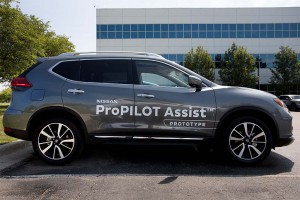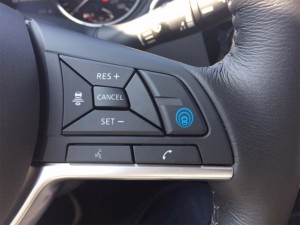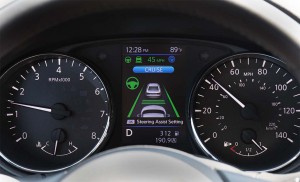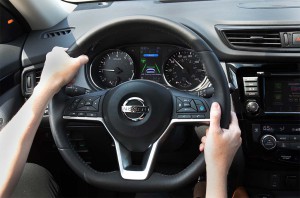Like parents helping their child learn to walk, automakers are trying to teach their cars how to drive on their own. And Nissan will take a big step closer to that goal later this year when an all-new version of the Leaf battery-electric vehicle comes to market.
The 2018 Nissan Leaf will see its range roughly doubled, the automaker signaling it will be able to deliver around 200 miles per charge. It also will feature a number of new technologies, including the e-Pedal system announced earlier this week, as well as something it has dubbed ProPilot Assist.
Nissan Chairman Carlos Ghosn has promised that the company will have its first fully autonomous car on the market by around 2020. But before then, Nissan plans to roll out a series of increasingly sophisticated, semi-autonomous driver assistance systems. ProPilot Assist is the latest. And we jumped at the chance to spend some time checking it out.
The term, ProPilot, might suggest that you’d be able to flip a switch and leave the driving to the new technology. But the telling part of the system is the word, “Assist.” In a presentation at the Nissan Technical Center in suburban Detroit, the automaker stressed that it’s a “building block.”
(To see more about the new Leaf and e-Pedal technology, Click Here.)
“What it isn’t is a self-driving feature,” explained Andy Christensen, Nissan’s Senior Manager of Intelligent Transportation System Research. “It does not have the capability of driving with the driver’s hands off the wheel.”
In other words, it doesn’t go quite as far as semi-autonomous systems offered by the likes of Tesla, Mercedes-Benz, Volvo or BMW. But, based on our initial drive, ProPilot Assist still had some features to appreciate.
We slipped behind the wheel of a modified Nissan Rogue (a heavily camouflaged version of the 2018 Leaf was parked nearby but not available for driving). Pulling out of the parking lot of the suburban Detroit tech center we headed out on a busy four-lane stretch of local roadway and flipped the switch to activate ProPilot Assist.
The system is, essentially, makes use of several technologies already found on many Nissan vehicles, notably active cruise control and forward collision warning with emergency braking. And it relies on both the car’s forward-looking radar and a camera mounted just above the rearview mirror provided by Israeli tech firm Mobileye.
Once activated, the driver sees a readout in the center of the gauge cluster that looks much like what you’d see with more conventional active cruise control. You can set both your desired speed and how close you want to follow a vehicle ahead of you. But the display now adds a steering wheel icon and two lines representing highway lane markers. When the wheel turns green and the lines bright yellow, ProPilot Assist is active.
For the first mile or so, it wasn’t, however. The pavement on the road was in poor condition and the lane markers often missing. Once we reached a smoother, more well-marked stretch, however, the warning lights signaled the system had come to life.
As Christensen stressed, ProPilot Assist is not a hands-free system. You need to keep your hands at least loosely on the wheel at all times. Take them off and you’ll get a series of escalating warning alerts. Eventually, the vehicle will slow and then come to a complete stop.
If you follow the rules, what you will quickly realize is that the system is effectively doing most of the work steering, however. And unlike less sophisticated Lane Keep systems, ProPilot plants you neatly in the center of the lane, rather than ping-ponging back and forth, as if the lane markers were rubber walls.
(Nissan offers tease of all-new ’18 Leaf EV. Click Here to check it out.)
Slipping onto a busy interstate, ProPilot showed both its capabilities and its limits. While the highway might be marked 70 mph, most traffic zooms along at 80, and at that speed, heading into a series of sweeping curves, ProPilot seemed to struggle a bit. It held to its lane, but just barely, nudging closer to the outside line marker.
According to Christensen, the system has designed-in limits in terms of how tight a turn it can take – an algorithm that takes into account both the radius of the turn and the vehicle’s speed.
In normal traffic, ProPilot Assist can speed up or slow down, holding to the traffic flow like Active Cruise. It can also come to a complete stop and then start up again with little to no driver intervention, a definite plus in stop-and-go, rush hour traffic.
But, as we experienced back on a local road, it has its limits. The system will only apply up to 40% of the maximum possible brake pressure. So, if the car ahead jams on its brakes, or if you are racing ahead and suddenly come to a stoplight with a car stopped in front of you, expect to have to apply the brakes on your own.
Considering such limitations, is ProPilot Assist worth it? Well, for one thing, we don’t know what it will cost, Nissan still deciding whether it will be an option or standard feature on the 2018 Leaf remake (and other vehicles to follow).
Around town, especially if you are driving local roads with poor lane markings, its appeal is likely to be limited. For those who do more freeway driving, however, it could be more appealing. And where it really shines is on a longer drive. Again, you can’t take your hands off the wheel for more than a couple seconds, but ProPilot Assist really will come in handy if you tend to drift off – and possibly drift out of you lane – something all too common on a trip.
(Nissan plans to double the number of vehicles with automatic emergency braking. Click Here for the story.)
What’s next? Nissan officials readily hint they will have more advanced semi-autonomous systems coming before 2020. We expect the next update to ProPilot Assist will allow the driver to tap the turn signal and have the vehicle automatically execute a pass – something offered by several competitors, including Mercedes – already. Each update should enhance the system’s appeal.




